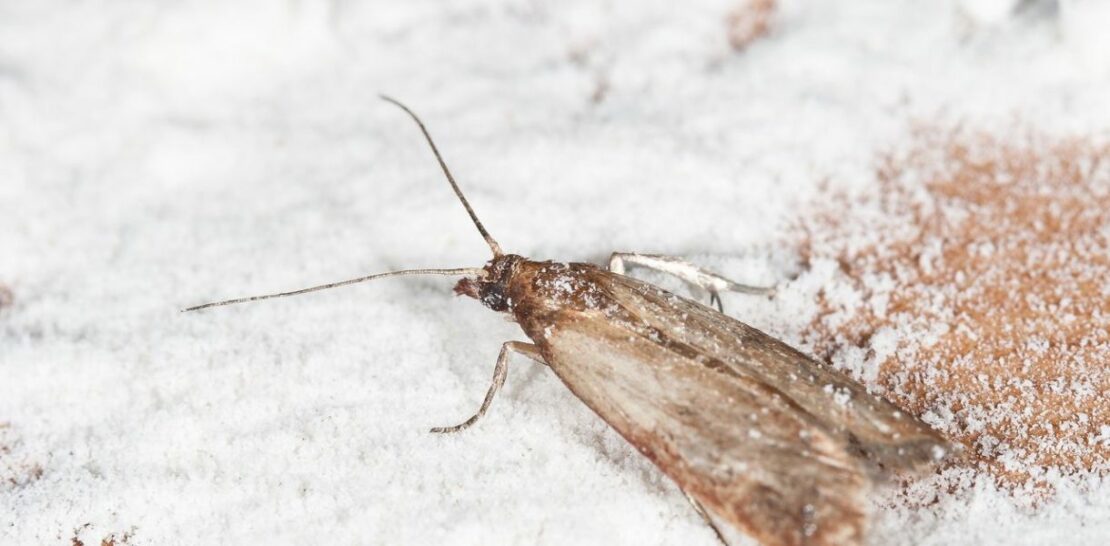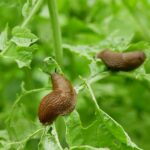Food moths, also known as pantry moths or Indian meal moths, are a common household pest that can wreak havoc on your pantry and stored food items.
These tiny insects are notorious for infesting dry goods such as flour, rice, pasta, cereals, and other grains, causing damage and waste.
If you’re tired of dealing with these pesky invaders, you’ve come to the right place!
In this comprehensive article, we’ll provide you with 20 expert tips to help you effectively get rid of food moths and prevent them from coming back.
Let’s dive in and reclaim your pantry from these unwelcome guests!
1. Know Your Enemy: Identifying Food Moths
Before you can effectively combat food moths, it’s essential to know what you’re up against. These insects are small, typically measuring between 1/4 to 1/2 inch in length, and have a wingspan of about 1/2 inch. The adult moths are usually a grayish-brown color, with their wings displaying a mix of lighter and darker bands.
When it comes to food moths, you’ll need to deal with both adult moths and their larvae. The larvae are small, white or off-white caterpillars that can be found crawling around in your pantry or inside your food packages. It’s these larvae that cause the most damage to your stored food items, as they feed on the grains and leave behind a web-like residue.
2. Inspect Your Pantry and Food Items
Once you’re familiar with what food moths look like, it’s time to inspect your pantry and food items for signs of infestation. Here are some key areas to focus on:
- Food packages: Check all your stored dry goods for any signs of moth activity, such as holes in the packaging, web-like residue, or the presence of larvae or adult moths. Be thorough, as these pests can easily find their way into sealed containers and plastic bags.
- Shelves and corners: Examine the corners and crevices of your pantry shelves for any signs of moth activity. Food moths often lay their eggs in these hard-to-reach areas, so it’s crucial to inspect them carefully.
- Other hiding spots: Don’t forget to check other potential hiding spots for food moths, such as under appliances or inside drawer joints. These pests can be quite resourceful when it comes to finding a place to lay their eggs.
3. Dispose of Infested Items
After identifying any infested food items, it’s essential to dispose of them immediately to prevent the moths from spreading further. This step may be disheartening, especially if it means throwing away large quantities of food, but it’s crucial for getting rid of food moths and safeguarding your remaining supplies.
When disposing of infested items, make sure to seal them in airtight bags or containers before placing them in the trash. This will help prevent any stray moths or larvae from escaping and infesting other areas of your home.
4. Clean and Sanitize Your Pantry
Cleaning and sanitizing your pantry is a crucial step in eliminating food moths and preventing future infestations. Follow these steps to ensure a thorough cleanup:
- Remove all items: Start by removing all food items and containers from your pantry, even if they don’t show any signs of infestation. This will give you full access to the shelves and crevices where moth eggs and larvae may be hiding.
- Wipe down surfaces: Use a mixture of warm water and soap to wipe down all surfaces in your pantry, including shelves, walls, and the floor. This will help remove any moth eggs, larvae, or residue left behind by the insects.
- Vacuum: Vacuum all crevices, corners, and shelf edges to ensure that you’ve removed any hidden moth eggs or larvae. Make sure to dispose of the vacuum bag or empty the canister immediately afterward to prevent any stray insects from escaping.
- Sanitize: Finish by using a bleach solution or pantry-safe disinfectant to sanitize all surfaces, paying special attention to corners and crevices. This will help kill any remaining moth eggs or larvae and deter future infestations.
- Bay leaves: Place a few dried bay leaves on pantry shelves or inside food containers to deter moths. The strong scent of bay leaves is unappealing to these pests and can help keep them at bay.
- Lavender: Dried lavender sachets can also be effective in repelling food moths. Place them in your pantry or cupboards to create a pleasant scent while warding off these unwelcome guests.
- Cedar: Cedar wood or cedar oil can help repel food moths, as well as other insects such as silverfish and cockroaches. Consider lining your pantry shelves with cedar planks or using cedar-scented products to create a moth-resistant environment.
5. Store Food in Airtight Containers
One of the most effective ways to prevent food moths from infesting your pantry is to store all your dry goods in airtight containers. These pests can easily chew through cardboard or plastic packaging, so investing in durable glass or plastic containers with tight-fitting lids is essential.
When transferring your food items into these containers, make sure to inspect the contents for any signs of moth activity and dispose of any infested items immediately. By keeping your pantry organized and using airtight containers, you’ll make it much harder for food moths to find a way in.
6. Use Moth Traps and Pheromone Lures
Another effective method for dealing with food moths is to use moth traps and pheromone lures. These traps contain a sticky substance that captures adult moths when they come into contact with it, while the pheromone lures, which mimic the scent of female moths, attract male moths to the trap.
Place these traps in strategic locations around your pantry and other areas where you’ve noticed moth activity. Replace the traps and lures regularly, as per the manufacturer’s instructions, to ensure their continued effectiveness. By capturing and eliminating adult moths, you’ll disrupt their breeding cycle and prevent them from laying more eggs.
7. Regularly Rotate and Inspect Your Food Items
Practicing good pantry hygiene can go a long way in preventing food moth infestations. Make it a habit to regularly rotate and inspect your food items, ensuring that you’re using up older products before opening new ones. This not only helps minimize the risk of infestation but also prevents food waste by ensuring that items don’t expire before you can use them.
During your routine inspections, keep an eye out for any signs of moth activity, such as holes in packaging, webbing, or the presence of larvae. If you spot any potential issues, take action immediately by disposing of the affected items and cleaning the surrounding area.
8. Seal Cracks and Crevices
Food moths are adept at finding their way into even the smallest cracks and crevices, so it’s essential to seal any potential entry points in your pantry and kitchen. Use caulk or another suitable sealant to fill gaps around shelves, baseboards, and walls, paying particular attention to corners and hard-to-reach areas where moths may lay their eggs.
By sealing potential entry points, you’ll not only make it more difficult for food moths to infiltrate your pantry but also discourage other pests, such as ants or mice, from making themselves at home.
9. Maintain a Clean and Clutter-Free Kitchen
Keeping a clean and clutter-free kitchen can help deter food moths and other pests from setting up shop in your home. Regularly clean countertops, floors, and appliances, making sure to remove any food spills or debris that could attract insects. Additionally, declutter your pantry and cupboards, ensuring that there are no hidden spaces for pests to hide or breed.
By maintaining a clean and organized kitchen, you’ll create an environment that’s less inviting to food moths and other unwanted visitors.
10. Use Natural Repellents
There are several natural substances that can help repel food moths and protect your pantry from infestation. Some popular options include:
While natural repellents can be helpful in deterring food moths, they should be used in conjunction with other prevention methods, such as proper food storage and regular cleaning, for maximum effectiveness.
11. Monitor Temperature and Humidity
Food moths thrive in warm, humid environments, so controlling the temperature and humidityin your pantry and kitchen can help make them less hospitable to these pests. Aim to keep the temperature below 70°F and the humidity below 50% to create an environment that’s less conducive to moth infestations.
You can use a hygrometer to monitor the humidity levels in your pantry and invest in a dehumidifier or moisture-absorbing products if necessary. Additionally, ensure proper ventilation and air circulation in your kitchen to help regulate temperature and humidity levels.
12. Keep Pet Food and Birdseed Stored Properly
Don’t forget that food moths can also infest pet food and birdseed, so it’s essential to store these items properly as well. Use airtight containers and keep them in a cool, dry place, preferably separate from your own food storage area.
Regularly inspect these items for signs of moth activity and dispose of any infested products immediately. By keeping pet food and birdseed secure, you’ll help prevent food moths from finding an alternative food source in your home.
13. Freeze Suspect Foods
If you’re unsure whether a food item is infested with moth larvae or eggs, you can freeze it for at least a week to kill off any potential pests. This is particularly useful for bulk items such as grains, flour, or nuts, which may have been exposed to moths before being brought into your home.
After freezing, transfer the food to airtight containers and store it as usual. This extra precaution can help ensure that you’re not inadvertently introducing moths into your pantry.
14. Inspect Groceries Before Unpacking
It’s possible that food moths can hitch a ride into your home via your groceries, so it’s a good practice to inspect all your food items before unpacking and storing them. Look for any signs of moth activity, such as holes in packaging or webbing, and dispose of any suspect items immediately.
By being vigilant about the items you’re bringing into your home, you can prevent food moths from sneaking their way into your pantry.
15. Install Door Sweeps and Window Screens
Another potential entry point for food moths is through gaps around doors and windows. Installing door sweeps and window screens can help keep these pests from gaining access to your home, as well as other insects like flies and mosquitoes.
Make sure to regularly inspect and repair your door sweeps and window screens to ensure that they’re doing their job effectively.
16. Use Diatomaceous Earth
Diatomaceous earth is a natural, non-toxic substance that can help control food moth infestations by damaging the exoskeletons of the insects, ultimately causing them to dehydrate and die. Sprinkle a thin layer of food-grade diatomaceous earth in your pantry, focusing on corners and crevices where moths may be hiding.
Be sure to reapply the diatomaceous earth every few weeks or after cleaning your pantry to maintain its effectiveness. While this method may not eliminate an infestation on its own, it can be a useful tool in conjunction with other prevention and control strategies.
17. Try Neem Oil
Neem oil, which is derived from the neem tree, is another natural substance that can help deter food moths. It acts as a natural insecticide, disrupting the hormones and reproductive systems of the insects, making it difficult for them to breed and lay eggs.
Apply a diluted neem oil solution to your pantry shelves and surfaces, ensuring that you cover all the areas where moths may be hiding. Reapply the solution every few weeks to maintain its effectiveness. As with other natural remedies, use neem oil in combination with additional prevention and control methods for the best results.
18. Introduce Beneficial Insects
Believe it or not, some insects can actually help control food moth infestations. Parasitic wasps, for example, lay their eggs inside the larvae of pantry moths, ultimately killing the pests. While this method may not be suitable for everyone, it can be an effective, natural way to manage food moth populations in some cases.
If you’re interested in introducing beneficial insects to your home, consult with a pest control professional or entomologist to ensure that you’re using the most appropriate species and methods for your specific situation.
19. Use a Vacuum Sealer
Vacuum sealing your dry goods can provide an extra layer of protection against food moths. By removing the airfrom the packaging, you’ll create an environment that’s inhospitable to these pests, making it difficult for them to infest your food items.
Invest in a vacuum sealer and use it to store your grains, flour, pasta, and other dry goods, particularly if you’re purchasing these items in bulk. Make sure to inspect the contents for any signs of moth activity before sealing, and dispose of any infested items immediately.
20. Consult a Pest Control Professional
If you’ve tried multiple methods to get rid of food moths and are still struggling with an infestation, it may be time to consult a pest control professional. These experts have the knowledge and tools necessary to effectively eliminate food moths from your home and can provide valuable advice on preventing future infestations.
When choosing a pest control professional, make sure to select a reputable company with experience in dealing with food moth infestations. They should be able to provide you with a comprehensive treatment plan tailored to your specific situation.
In conclusion, dealing with food moths can be a frustrating and time-consuming task, but with the right strategies and persistence, you can effectively eliminate these pests from your home. By combining preventative measures, such as proper food storage and regular pantry cleaning, with targeted treatments like moth traps and natural repellents, you can reclaim your pantry and protect your stored food items from these unwelcome invaders. Remember, the key to success lies in being thorough and consistent in your efforts, and don’t hesitate to consult a pest control professional if you need additional assistance. Good luck, and here’s to a food moth-free home!




